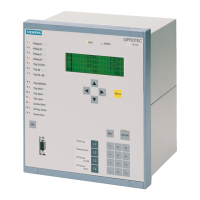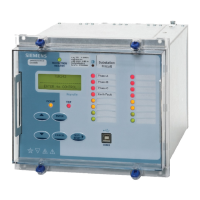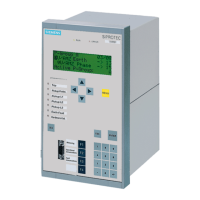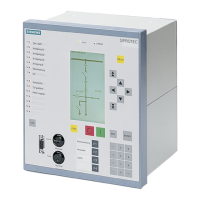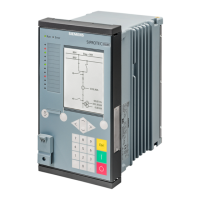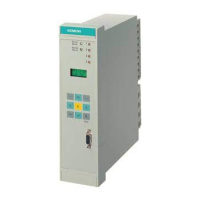Do you have a question about the Siemens 7UT51 and is the answer not in the manual?
Provides information required to install and operate the Siemens 7UT51 Differential Protective Relay, including functions, features, and application examples.
Defines key terms and acronyms used throughout the manual, such as CT, CTR, MMI, and NV-RAM.
Provides a general overview of the 7UT51 multifunction protective relay and its capabilities for various power system equipment.
Details the key features of the 7UT51 relay, including microprocessor-based implementation, mathematical current matching, and various protection functions.
Explains how to generate the catalog or model number by inserting option codes into the appropriate boxes.
Lists the protection functions available for the 7UT513 and 7UT512 models at 60Hz, noting frequency effects on auxiliary functions.
Details the specifications for current inputs, DC supply power, trip contacts, signal contacts, and binary-signal inputs of the relay.
Describes the settings, inherent operating times, dropout ratios, operating tolerances, and environmental effects for transformer differential protection.
Details the settings, operating times, tolerances, and environmental influences for motor/generator differential protection.
Outlines the settings, inherent operating times, tolerances, and environmental effects for bus differential protection.
Specifies settings, inherent operating times, tolerances, and environmental influences for optional ground differential protection.
Details specifications for overcurrent protection, including settings, inherent operating times, tolerances, and environmental influences.
Describes specifications for thermal overload protection, including settings, trip time characteristic, tolerances, and environmental influences.
Details specifications for tank leakage protection, including measuring principle, settings, inherent operating times, and operating tolerances.
Provides guidelines for handling, storage, and transport of the relay, including climatic conditions and electromagnetic compatibility.
Illustrates typical two- and three-winding transformer protection schemes, including differential and backup overcurrent protection.
Explains how ground differential, overcurrent, and thermal overload elements can protect reactors.
Details schemes for protecting single motors/generators and unit-connected generator-transformer systems.
Describes bus protection schemes using the 7UT513, including radial distribution systems and feeder breaker configurations.
Explains the principle of transformer differential protection based on Kirchoff's current law and current matching.
Details the addresses used to provide the relay with information about the protected transformer, including windings and voltage.
Explains the CT information required, including secondary rating, primary rating, orientation, and zero-sequence current processing.
Describes the differential and restraining current calculations and the trip characteristic settings.
Details the special feature for restraining tripping during high-current through-faults due to unequal CT saturation.
Explains the use of second-harmonic current to block differential protection during transformer inrush conditions.
Covers restraint based on excessive third, fourth, or fifth harmonic currents from non-fault conditions like overexcitation.
Describes how transformer differential protection is blocked if system frequency deviates significantly from nominal.
Details the time delay settings for 87T and 87HS pickup to trip, and reset time delays.
Describes events that control and are generated by the 87T/87HS function, including logic and output actions.
Explains the matrix equations for matching currents and handling zero sequence current for single-phase transformers.
Explains differential protection for motors and generators based on Kirchoff's current law and accounting for non-ideal components.
Details information needed for protected objects and associated CTs, including voltage, frequency, and apparent power.
Explains CT information required: orientation, nominal primary rating, nominal secondary rating, and ground-current input usage.
Describes differential and restraining current calculations and trip characteristic settings for motors/generators.
Details the feature to restrain tripping during high-current through-faults due to unequal CT saturation.
Explains how motor/generator differential protection is blocked if the system frequency deviates from nominal.
Details time delay settings for 87M/G pickup to trip and reset time delays.
Describes events that control and are generated by the 87M/G function, including logic and output actions.
Explains bus differential protection based on Kirchoff's law, accounting for non-ideal components and CT behavior.
Details information needed for protected buses and associated CTs, including object type, CT rating, and frequency.
Explains CT information required: nominal primary rating, nominal secondary rating, and orientation of CTs.
Describes differential and restraining current calculations and trip characteristic settings for bus protection.
Details the feature to restrain tripping during high-current through-faults due to unequal CT saturation.
Explains the continuous monitoring of differential currents for CT circuit problems and alarm annunciation.
Details time delay settings for 87B pickup to trip and reset time delays.
Describes events that control and are generated by the 87B function, including logic and output actions.
Details the calculation of restraining current, zero sequence current vectors, and differential current.
Explains how the algorithm makes a trip decision based on calculated quantities, classical and extended trip areas.
Describes using second harmonic restraint to detect inrush and avoid blocking internal faults with CT saturation.
Explains how to set the ground differential function to exist or not exist and its normal operational status.
Determines restraint based on phase displacement between currents and the critical limit angle setting.
Covers restraint based on second, third, fourth, or fifth harmonic currents and disabling restraint under certain conditions.
Details time delay settings for 87N pickup to trip and reset time delays.
Describes events that control and are generated by the 87N function, including logic and output actions.
Explains how 50HS and 50/51 elements operate, including pickup, trip, and inverse time characteristics.
Details how to set the overcurrent elements to be Non-Existent/Disabled or select the reference side.
Describes the high-set overcurrent element's pickup threshold and time delay settings.
Explains the definite-time (50) or inverse-time (51) overcurrent element with ANSI characteristic curves.
Specifies the additional time to remain in trip state after dropout of an overcurrent element.
Describes how overcurrent element behavior can be changed during manual breaker closing via binary input.
Lists events that control and are generated by the 50/51 and 50HS functions, including logic and output actions.
Explains how thermal overload elements calculate temperature rise using a single-body thermal model.
Details how to set thermal overload elements as Non-Existent/Disabled or monitor specific windings/sides.
Covers maximum continuous overload current, time constant, warning alarm levels, and temperature rise calculation.
Describes events controlling and generated by the 49-1 and 49-2 functions, including logic and output actions.
Explains tank leakage protection operation using overcurrent element principles and CT measurement.
Details how to set the tank leakage element as NON-EXISTENT/DISABLED or monitor absolute/multiple current.
Specifies pickup and dropout levels for tank leakage protection, considering sensitive and insensitive CT inputs.
Details time delay settings for tank leakage protection pickup to trip and reset time delays.
Describes events that control and are generated by the 64T function, including logic and output actions.
Describes the signal contact dedicated to reporting the relay's operational readiness and marshalling to status contacts.
Details the relay's monitoring of internal components like processor, power supplies, converters, and trip circuits.
Explains how failure or switch-off of DC supply voltage affects relay operation and the self-monitor signal contact.
Describes how the relay detects CT circuit interruptions or short circuits by monitoring current plausibility.
Lists events that control and are generated by self-monitoring features, including their LCD abbreviation, event number, and I/O status.
Describes how to program the relay for communication via binary inputs, signal outputs, and trip contacts.
Explains binary-signal inputs, their actuation by voltage, and their ability to control up to ten events.
Details programmable signal contact outputs, how they are controlled by functions, and their capabilities.
Describes how LEDs on the front panel are controlled by functions, their configuration, and default assignments.
Explains how trip signals are sent to circuit breakers via closing trip contacts, including relay capabilities.
Describes how to incorporate external trip signals into 7UT51 processing, including normal status and time delays.
Provides a numerical list of marshalling possibilities for signal contacts, trip contacts, and LEDs.
Introduces the integral keypad and other features of the front panel, including the display and on/off switch.
Explains two methods to view or change memory address contents: direct addressing and scrolling.
Details procedures for changing settings, including entering password mode and modifying values or list options.
Describes storing up to four sets of protection settings for rapid switching, enabling seasonal or other changes.
Explains how the relay records event messages, including pickup, dropout, trips, and diagnostics.
Details system data collected and calculated by the relay, displayable on the LCD or exportable to a PC.
Explains how to record waveform data before, during, and after a fault, initiated by various events or manually.
Lists the main address blocks and their corresponding functions for relay settings and configuration.
Describes configuration settings that apply to all relay applications, including display appearance and event updates.
Specifies addresses for LCD display appearance and content, and how events update LCD and LED states.
Explains how to enable the capability to use multiple settings groups for rapid switching between configurations.
Details how to set the relay's date and time, requiring password entry and confirmation.
Introduces WinDIGSI software for configuring, programming, and analyzing data from the 7UT51 relay via PC.
Guides on programming the relay using a PC and WinDIGSI software, including required information entry.
Lists menu choices within the Parameter menu, including Configuration, Marshalling, Settings, Control, Annunciations, and Fault.
Lists essential test equipment, including power sources, current sources, timers, ohmmeters, and DC voltage sources.
Provides crucial notes for bench testing, including current limitations, output contact ratings, and input voltage limits.
Covers testing procedures for transformer differential protection, including ideal through-fault tests and metering validation.
Details tests for restricted ground fault protection, based on application shown in Figure 16.9.
Describes testing the differential protection function for branch points, requiring specific configuration and test currents.
Covers testing backup overcurrent time protection, requiring assignment to a side or virtual object and specific status settings.
Explains testing procedures for thermal overload protection, including warning and trip tests for 49-1 and 49-2 elements.
Details testing for tank leakage protection, including applying test current and confirming pickup and trip behavior.
Describes checking the coupling of external trip signals and their processing via binary inputs.
Guides on checking settings, programming, and switching on protection functions before placing the relay into service.
Provides guidelines for transporting and storing the relay in its original packaging to protect from mechanical shock.
Shows an exploded view of relay packaging material and advises against using a damaged relay.
Describes procedures for removing and inserting relay modules for installation and maintenance.
Details steps for mounting the relay case onto a panel, including drilling, module removal, and ground strap connection.
Illustrates screw terminals and ring lugs for signal, trip, current, and power supply connections.
Provides checks for continuity, polarity, phase relationship, and grounding of current transformer circuits.
Details the procedure for replacing the internal fuse, including selecting the correct fuse and handling precautions.
Describes how to install or replace the backup battery, ensuring continuous power for event logs and the internal clock.
Explains hardware modification procedures to change the rated nominal current of current inputs and ground-current inputs.
Details hardware modification to change the actuating voltage for binary-signal inputs to a different voltage.
Describes how to change the normal signal position of the fiberoptic data port from 'Light Off' to 'Light On'.
Covers physical inspection, checking connections, verifying settings, and preparing for primary tests.
Details symmetrical current tests for differential current and phase angle relations using relay panel or WinDIGSI.
Describes testing procedures for three-winding transformers and branch points, modifying test arrangements as needed.
Explains when zero sequence current tests are necessary and describes test arrangements for different configurations.
Details the zero sequence current test for restricted ground fault protection, including metering and phase relationship checks.
Explains how to leave test operation and return the relay to normal service, including resetting indicators.
Describes checking the coupling of external trip signals and their processing via binary inputs.
Covers operational checks after wire checking and primary tests, including verifying trip commands and overall system function.
Guides on energizing the protected object, performing in-service readings, and checking measured values.
Describes installing the 7UT51 relay in an energized circuit without disturbing the existing system.
Advises performing only tests applicable to setting changes and verifying output connections.
Guides on checking settings, programming, and switching on protection functions before placing the relay into service.
Provides checks to perform if the relay indicates a defect or if programmable LEDs are not lit.
Recommends routine checks for interfaces and simulation of internal short circuits for analog input verification.
Advises on procedures for returning a relay to the manufacturer if problems cannot be corrected locally.
Provides information required to install and operate the Siemens 7UT51 Differential Protective Relay, including functions, features, and application examples.
Defines key terms and acronyms used throughout the manual, such as CT, CTR, MMI, and NV-RAM.
Provides a general overview of the 7UT51 multifunction protective relay and its capabilities for various power system equipment.
Details the key features of the 7UT51 relay, including microprocessor-based implementation, mathematical current matching, and various protection functions.
Explains how to generate the catalog or model number by inserting option codes into the appropriate boxes.
Lists the protection functions available for the 7UT513 and 7UT512 models at 60Hz, noting frequency effects on auxiliary functions.
Details the specifications for current inputs, DC supply power, trip contacts, signal contacts, and binary-signal inputs of the relay.
Describes the settings, inherent operating times, dropout ratios, operating tolerances, and environmental effects for transformer differential protection.
Details the settings, operating times, tolerances, and environmental influences for motor/generator differential protection.
Outlines the settings, inherent operating times, tolerances, and environmental effects for bus differential protection.
Specifies settings, inherent operating times, tolerances, and environmental influences for optional ground differential protection.
Details specifications for overcurrent protection, including settings, inherent operating times, tolerances, and environmental influences.
Describes specifications for thermal overload protection, including settings, trip time characteristic, tolerances, and environmental influences.
Details specifications for tank leakage protection, including measuring principle, settings, inherent operating times, and operating tolerances.
Provides guidelines for handling, storage, and transport of the relay, including climatic conditions and electromagnetic compatibility.
Illustrates typical two- and three-winding transformer protection schemes, including differential and backup overcurrent protection.
Explains how ground differential, overcurrent, and thermal overload elements can protect reactors.
Details schemes for protecting single motors/generators and unit-connected generator-transformer systems.
Describes bus protection schemes using the 7UT513, including radial distribution systems and feeder breaker configurations.
Explains the principle of transformer differential protection based on Kirchoff's current law and current matching.
Details the addresses used to provide the relay with information about the protected transformer, including windings and voltage.
Explains the CT information required, including secondary rating, primary rating, orientation, and zero-sequence current processing.
Describes the differential and restraining current calculations and the trip characteristic settings.
Details the special feature for restraining tripping during high-current through-faults due to unequal CT saturation.
Explains the use of second-harmonic current to block differential protection during transformer inrush conditions.
Covers restraint based on excessive third, fourth, or fifth harmonic currents from non-fault conditions like overexcitation.
Describes how transformer differential protection is blocked if system frequency deviates significantly from nominal.
Details the time delay settings for 87T and 87HS pickup to trip, and reset time delays.
Describes events that control and are generated by the 87T/87HS function, including logic and output actions.
Explains the matrix equations for matching currents and handling zero sequence current for single-phase transformers.
Explains differential protection for motors and generators based on Kirchoff's current law and accounting for non-ideal components.
Details information needed for protected objects and associated CTs, including voltage, frequency, and apparent power.
Explains CT information required: orientation, nominal primary rating, nominal secondary rating, and ground-current input usage.
Describes differential and restraining current calculations and trip characteristic settings for motors/generators.
Details the feature to restrain tripping during high-current through-faults due to unequal CT saturation.
Explains how motor/generator differential protection is blocked if the system frequency deviates from nominal.
Details time delay settings for 87M/G pickup to trip and reset time delays.
Describes events that control and are generated by the 87M/G function, including logic and output actions.
Explains bus differential protection based on Kirchoff's law, accounting for non-ideal components and CT behavior.
Details information needed for protected buses and associated CTs, including object type, CT rating, and frequency.
Explains CT information required: nominal primary rating, nominal secondary rating, and orientation of CTs.
Describes differential and restraining current calculations and trip characteristic settings for bus protection.
Details the feature to restrain tripping during high-current through-faults due to unequal CT saturation.
Explains the continuous monitoring of differential currents for CT circuit problems and alarm annunciation.
Details time delay settings for 87B pickup to trip and reset time delays.
Describes events that control and are generated by the 87B function, including logic and output actions.
Details the calculation of restraining current, zero sequence current vectors, and differential current.
Explains how the algorithm makes a trip decision based on calculated quantities, classical and extended trip areas.
Describes using second harmonic restraint to detect inrush and avoid blocking internal faults with CT saturation.
Explains how to set the ground differential function to exist or not exist and its normal operational status.
Determines restraint based on phase displacement between currents and the critical limit angle setting.
Covers restraint based on second, third, fourth, or fifth harmonic currents and disabling restraint under certain conditions.
Details time delay settings for 87N pickup to trip and reset time delays.
Describes events that control and are generated by the 87N function, including logic and output actions.
Explains how 50HS and 50/51 elements operate, including pickup, trip, and inverse time characteristics.
Details how to set the overcurrent elements to be Non-Existent/Disabled or select the reference side.
Describes the high-set overcurrent element's pickup threshold and time delay settings.
Explains the definite-time (50) or inverse-time (51) overcurrent element with ANSI characteristic curves.
Specifies the additional time to remain in trip state after dropout of an overcurrent element.
Describes how overcurrent element behavior can be changed during manual breaker closing via binary input.
Lists events that control and are generated by the 50/51 and 50HS functions, including logic and output actions.
Explains how thermal overload elements calculate temperature rise using a single-body thermal model.
Details how to set thermal overload elements as Non-Existent/Disabled or monitor specific windings/sides.
Covers maximum continuous overload current, time constant, warning alarm levels, and temperature rise calculation.
Describes events controlling and generated by the 49-1 and 49-2 functions, including logic and output actions.
Explains tank leakage protection operation using overcurrent element principles and CT measurement.
Details how to set the tank leakage element as NON-EXISTENT/DISABLED or monitor absolute/multiple current.
Specifies pickup and dropout levels for tank leakage protection, considering sensitive and insensitive CT inputs.
Details time delay settings for tank leakage protection pickup to trip and reset time delays.
Describes events that control and are generated by the 64T function, including logic and output actions.
Describes the signal contact dedicated to reporting the relay's operational readiness and marshalling to status contacts.
Details the relay's monitoring of internal components like processor, power supplies, converters, and trip circuits.
Explains how failure or switch-off of DC supply voltage affects relay operation and the self-monitor signal contact.
Describes how the relay detects CT circuit interruptions or short circuits by monitoring current plausibility.
Lists events that control and are generated by self-monitoring features, including their LCD abbreviation, event number, and I/O status.
Describes how to program the relay for communication via binary inputs, signal outputs, and trip contacts.
Explains binary-signal inputs, their actuation by voltage, and their ability to control up to ten events.
Details programmable signal contact outputs, how they are controlled by functions, and their capabilities.
Describes how LEDs on the front panel are controlled by functions, their configuration, and default assignments.
Explains how trip signals are sent to circuit breakers via closing trip contacts, including relay capabilities.
Describes how to incorporate external trip signals into 7UT51 processing, including normal status and time delays.
Provides a numerical list of marshalling possibilities for signal contacts, trip contacts, and LEDs.
Introduces the integral keypad and other features of the front panel, including the display and on/off switch.
Explains two methods to view or change memory address contents: direct addressing and scrolling.
Details procedures for changing settings, including entering password mode and modifying values or list options.
Describes storing up to four sets of protection settings for rapid switching, enabling seasonal or other changes.
Explains how the relay records event messages, including pickup, dropout, trips, and diagnostics.
Details system data collected and calculated by the relay, displayable on the LCD or exportable to a PC.
Explains how to record waveform data before, during, and after a fault, initiated by various events or manually.
Lists the main address blocks and their corresponding functions for relay settings and configuration.
Describes configuration settings that apply to all relay applications, including display appearance and event updates.
Specifies addresses for LCD display appearance and content, and how events update LCD and LED states.
Explains how to enable the capability to use multiple settings groups for rapid switching between configurations.
Details how to set the relay's date and time, requiring password entry and confirmation.
Introduces WinDIGSI software for configuring, programming, and analyzing data from the 7UT51 relay via PC.
Guides on programming the relay using a PC and WinDIGSI software, including required information entry.
Lists menu choices within the Parameter menu, including Configuration, Marshalling, Settings, Control, Annunciations, and Fault.
Lists essential test equipment, including power sources, current sources, timers, ohmmeters, and DC voltage sources.
Provides crucial notes for bench testing, including current limitations, output contact ratings, and input voltage limits.
Covers testing procedures for transformer differential protection, including ideal through-fault tests and metering validation.
Details tests for restricted ground fault protection, based on application shown in Figure 16.9.
Describes testing the differential protection function for branch points, requiring specific configuration and test currents.
Covers testing backup overcurrent time protection, requiring assignment to a side or virtual object and specific status settings.
Explains testing procedures for thermal overload protection, including warning and trip tests for 49-1 and 49-2 elements.
Details testing for tank leakage protection, including applying test current and confirming pickup and trip behavior.
Describes checking the coupling of external trip signals and their processing via binary inputs.
Guides on checking settings, programming, and switching on protection functions before placing the relay into service.
Provides guidelines for transporting and storing the relay in its original packaging to protect from mechanical shock.
Shows an exploded view of relay packaging material and advises against using a damaged relay.
Describes procedures for removing and inserting relay modules for installation and maintenance.
Details steps for mounting the relay case onto a panel, including drilling, module removal, and ground strap connection.
Illustrates screw terminals and ring lugs for signal, trip, current, and power supply connections.
Provides checks for continuity, polarity, phase relationship, and grounding of current transformer circuits.
Details the procedure for replacing the internal fuse, including selecting the correct fuse and handling precautions.
Describes how to install or replace the backup battery, ensuring continuous power for event logs and the internal clock.
Explains hardware modification procedures to change the rated nominal current of current inputs and ground-current inputs.
Details hardware modification to change the actuating voltage for binary-signal inputs to a different voltage.
Describes how to change the normal signal position of the fiberoptic data port from 'Light Off' to 'Light On'.
Covers physical inspection, checking connections, verifying settings, and preparing for primary tests.
Details symmetrical current tests for differential current and phase angle relations using relay panel or WinDIGSI.
Describes testing procedures for three-winding transformers and branch points, modifying test arrangements as needed.
Explains when zero sequence current tests are necessary and describes test arrangements for different configurations.
Details the zero sequence current test for restricted ground fault protection, including metering and phase relationship checks.
Explains how to leave test operation and return the relay to normal service, including resetting indicators.
Describes checking the coupling of external trip signals and their processing via binary inputs.
Covers operational checks after wire checking and primary tests, including verifying trip commands and overall system function.
Guides on energizing the protected object, performing in-service readings, and checking measured values.
Describes installing the 7UT51 relay in an energized circuit without disturbing the existing system.
Advises performing only tests applicable to setting changes and verifying output connections.
Guides on checking settings, programming, and switching on protection functions before placing the relay into service.
Provides checks to perform if the relay indicates a defect or if programmable LEDs are not lit.
Recommends routine checks for interfaces and simulation of internal short circuits for analog input verification.
Advises on procedures for returning a relay to the manufacturer if problems cannot be corrected locally.
| Rated Current | 1 A or 5 A |
|---|---|
| Current inputs | 6 |
| Current Input | 1 A or 5 A |
| Frequency | 50 Hz, 60 Hz |
| Communication Protocol | IEC 60870-5-103, Modbus |
| Protection Functions | Differential protection, Overcurrent protection |
| Display | LCD |
| Mounting | Rack mounting |
| Housing | metal |
| Standards Compliance | IEC 60255 |



